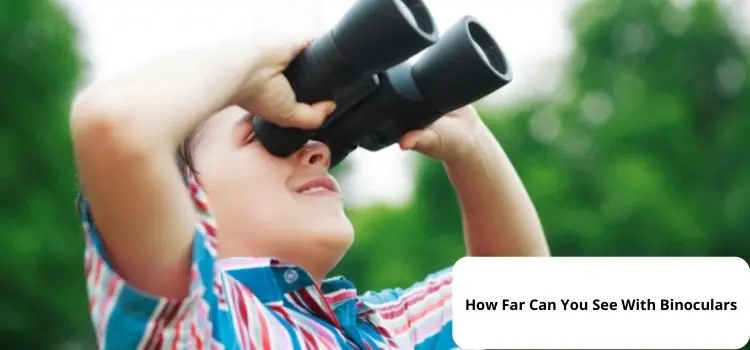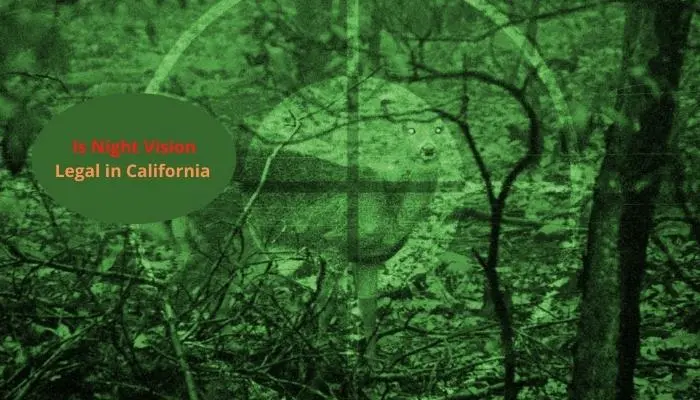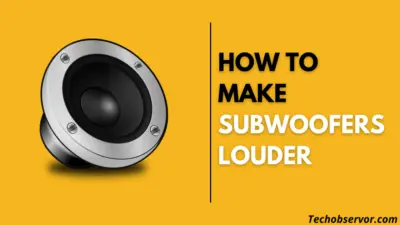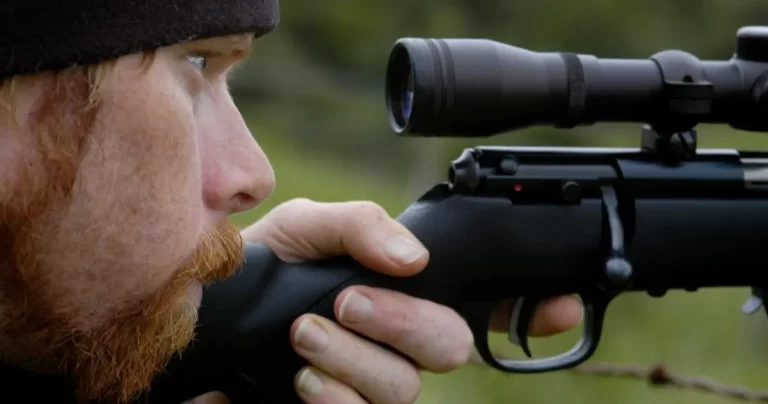How Far Can You See With Binoculars| A Comprehensive Guide
Human eyes cannot follow a bird flying too high in the sky or a deer running in the forest. For this reason, binoculars allow us to see yards away without having to leave our place. Since the purpose of binoculars is to cut the distance between us and our target, making it watchable to us, people often ask one question: “How far can you see with binoculars?”
Quick Answer: The higher the magnification of binoculars, the farther they’ll be from your naked eye. The number of the binocular magnification determines how close our target will be seen to us. If the binocular is 8x, it means that if we look through it, we’ll be able to see our target 8 times better than our actual vision.
Best Hunting Binoculars 2022 | Perfect For Your Next Hunting Trip!
If you’re in a hurry, then that’s all you need to know. However, if you’re a birder, hunter, skater, or traveller who wants to know more about the topic, then read on!
How Far Can You See With Binoculars?
The ability of the binoculars to show us a target near us depends on a lot of factors. And to get the answer to this question, you’ll have to go over them profoundly. This way, you’ll understand what things determine the ability of the binoculars to see and how much each of them would be better for you to get good results.
Binoculars Specifications That Affect Their Vision
The majority of the audience believes that the binoculars are used to gain distance in order to show the object. Isn’t that true? Absolutely not. The purpose of binoculars is to magnify the object that you want to look at. So, do not ask, “How far can you see with binoculars?” Instead, ask, “How far can I magnify my target, scene, or prey?”
1) Magnification
Consider magnification as the power of the binoculars. The higher it is, the farther you’ll be able to see through your binoculars. And the simplest way to determine how far you can see with binoculars is to multiply the binocular magnification by your vision.
You’ll be able to see farther with your naked eye if the number is higher. So, does it mean that going for the binoculars with the highest magnification is the best choice? Yes, you should, but only after knowing about its downsides and pros of it.
The Pros of High Magnification
- Much closer examination of targets.
- It is tripod-mountable for steady use.
- Large apertures can also be useful for low-light observation.
- Does a Great job in hunting.
- Details can be resolved at larger distances.
- Amateur astronomy
So, it boils down to the result that high magnification is the way to see the farthest through your magnification. But wait…consider the disadvantages before deciding on high magnification binoculars.
Downsides to High Magnification
- Very hard to use since it makes the binoculars heavier.
- A narrow view of the field.
- Tunnelling.
- Vibrations cause unstable vision.
- Optical assembly and quality that cannot deliver high power.
So, if you’re planning to go with the high magnification, then you surely can. However, keep these downsides in mind as well. Who should go with the high magnification? Hunters and birders can go with it.
Because they usually have their vans or a location where they spend the majority of their time waiting for their prey or birds, they can easily use the tripod to mount their binoculars and make it quite easy to use. However, the other above-mentioned issues will still be there, but you’ll have to compromise a little on them.
2) Objective Lens Size
The objective lenses of a binocular are placed in the front of the optics, closest to the target being viewed. Light gathering is one of the primary functions of an objective lens.
The larger the lens, the more light it can collect. It is commonly measured in millimetres (mm). When the binoculars collect more light, the image becomes clearer. It can also help you see more clearly in low-light circumstances.
With light producing greater quality images, you will be able to see details in locations that were previously unobservable with your eyes alone.
3) The Exit Pupil
The light collected by binocular optics is converted into a beam of light that you view via the eyepieces. You may compute the exit pupil diameter of a binocular by dividing the objective lens size by the magnification.
Under normal lighting circumstances, the human eye opens to around 2mm and becomes broader under darker conditions. The image will appear darker and less detailed if your pupil is larger than the exit pupil diameter.
This is important to remember, especially if you hunt in low-light conditions or use binoculars to stargaze.
These parts of the binoculars affect their ability to see. However, these are not the only factors that influence our ability to see; there are two others that have a significant impact on how far we can see with binoculars. So let’s learn about these things.
Other Things That Affect the Vision of Our Binoculars
The distance you can see with binoculars or the naked eye on Earth is primarily determined by two factors: air quality and the curvature of the Earth. The resolution determines how finely you can see distant objects and how well you can recognize details.
1: Horizon
The curvature of the planet also influences how far we can see; you may have seen a ship disappear behind the horizon. It’s only around three miles from the beach to where the ship fades into the horizon.
As a result, everyone is presumably familiar with the horizon’s limits from personal experience. After all, you know that climbing a tree or a tower allows you to see much further, and being on top of a mountain can provide a truly breathtaking perspective.
2:Atmospheric Conditions
You’ve probably observed how rain or fog alters what and how far you can see. So you’ve seen the effects of weather (clouds, fog, rain, etc.) and air pollution firsthand (dust, sandstorms, smog, exhaust gases, etc.). When the weather is cloudy and foggy or the air is extremely polluted, we cannot see as far as we can when it is clear.
3: Angular Resolution
There is no limit to the distance we can see. However, the level of detail we can perceive is limited. And how detailed we can perceive is determined by the human eye’s resolution. More precisely, the human eye’s angular resolution.
The ability to discern small structures is referred to as angular resolution (resolving power). In layman’s terms, the minimal distance between items is required to recognise them as separate objects.
A relaxed, healthy human eye can resolve two spots separated by only one arc minute. This works from a few inches to infinity. Unfortunately, at close range, this capacity diminishes with age. (Presbyopia)
When something is far away, we simply cannot perceive the small features because they are too near to one another for our eyes’ resolution to separate them; they appear to be blended and appear as one.
With the use of optical equipment, we can magnify microscopic items (microscope) or bring distant and hence small-appearing objects closer (enlarge) and thus look at them in greater detail.
However, the rules of optics limit the capabilities of an optical device. The Rayleigh criterion defines the shortest distance that an optical device can resolve. This has to do with diffraction, wavelength, and aperture width. The bottom line is that larger is preferable for detailed viewing.
What Are the Best Long-Distance Binoculars?
Now you’re aware of how far you can see with your binoculars. However, what are the best binoculars that help you see at a very long distance? It’s difficult to say which binoculars are best for long-distance viewing because it depends on how detailed you want to see distant objects.
I can see a ship that is a long distance away on the horizon with 7x magnification. But if I want to see who is on the bridge, then I really need a lot more magnifying power.
Large binoculars with magnification powers of 15, 20, or 40 times are available, but they are so large that you can’t hold them wobbly — they must be firmly set on tripods.
Spotting scopes or telescopes are very useful for seeing objects clearly at a vast distance while still recognising details. These have superior resolution and can see further than binoculars due to their better optics. Of course, they are no longer as compact or as easy to move.
A tripod is also required because holding the instrument in your hand without trembling is difficult at magnifications of more than 12 times.
FAQs
1: How far can you see with 20×80 binoculars?
They have a tight focus distance of 108 feet, which means you won’t be able to focus on anything closer. Second, unlike smaller binoculars, large binoculars are a touch too weighty to be readily carried around and used.
2: How far can you see with 20×50 binoculars?
At distances of up to 900 yards, they are ideal. Much better at gathering light than the 8×28 units we previously utilised. They are lightweight and easy to use for long periods of time.
3:Can you see 50 miles away?
Have you ever looked out at the sea? The farthest point visible is around 3 miles away. 6 miles: The typical 747 passenger airliner travels at 6.6 miles per hour. City buildings can be visible from 50 miles away (if standing on the ground) on clear days.
4: What does 30 x 60 mean in binoculars?
The long and short of it is that they are marketed as “30×60” binoculars, which indicates 30x magnification and a 60mm objective lens (although, in an attempt to be clever, the binocular itself says “30*60”). Back to reality, they are 8×21 objectives (8x magnification, 21mm).
Conclusion
How far can you see with the binoculars? It depends on the number of magnifications your binoculars have. The greater the magnification results in a closer view. However, higher magnification has its downsides as well, which you must watch out for.
Like, the high magnification makes the binoculars a little heavier, hence making them quite difficult to hold and operate. It makes the view of the field narrow, which you’d never want to have as a birder or a traveller. Not only that, the vibration makes the binoculars unstable as well. Keep these things in your mind while choosing any of the binoculars.
So, now you know how far you can see with your binoculars. That’s all for today. I hope everything was easier for you to comprehend. Because I’ve tried my best to make you understand everything in a good way. But still, if you have any questions related to the topic, please let me know in the comment section. I’d love to help you out.I hope you will be clear now after reading to know how far can you see with binoculars.








